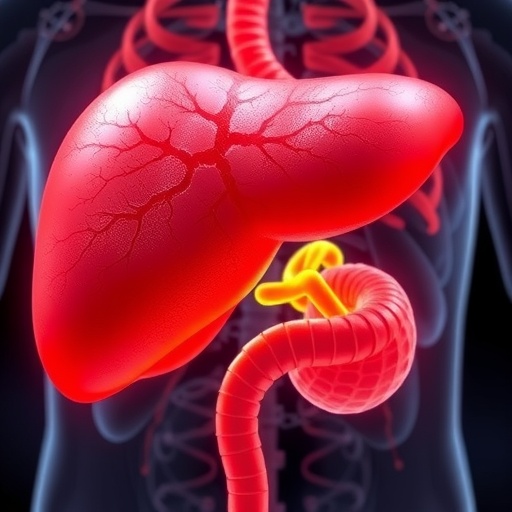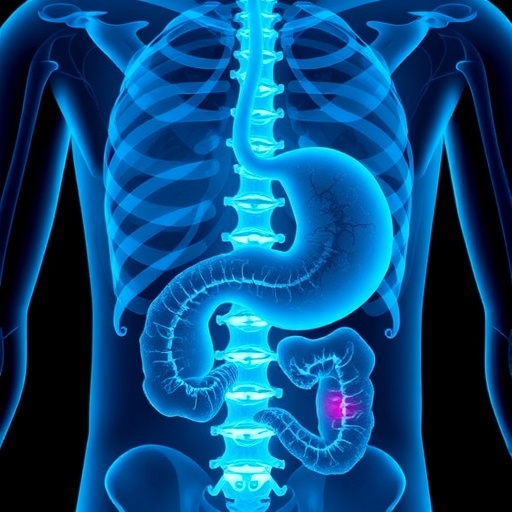In a groundbreaking study emerging from China, researchers have unveiled a critical metabolic mechanism that exacerbates the metastasis of hepatocellular carcinoma (HCC), the predominant form of primary liver cancer. This discovery highlights the role of tumor-associated macrophages (TAMs) as a novel and pivotal source of acetate within the tumor microenvironment, fundamentally altering the metabolic landscape that drives cancer progression and dissemination.
Acetate, a simple two-carbon molecule, has garnered considerable interest due to its integral role in oncogenic metabolism. It serves as a substrate for the synthesis of acetyl-coenzyme A (acetyl-CoA), a key metabolic intermediate intricately involved in the catabolism of glucose, lipids, and amino acids. Beyond its metabolic duties, acetyl-CoA functions as a crucial signaling molecule, facilitating lysine acetylation on histones and other proteins, thereby influencing gene expression and cellular behavior. Elevated acetyl-CoA levels have been consistently linked with aggressive metastatic phenotypes in various cancers, emphasizing the need to understand acetate’s origins within tumor niches.
Previous investigations have noted a perplexing discrepancy: acetate concentrations in the bloodstream are significantly lower than those found within cancerous tissues. This disparity suggested that acetate production was localized within the tumor microenvironment itself. Yet, the precise cellular sources and pathways responsible remained elusive until the recent study conducted by Dr. LU Ming and colleagues from the Shanghai Institute of Nutrition and Health, in partnership with Huashan Hospital at Fudan University.
Their research illuminates a sophisticated metabolic crosstalk between HCC cells and TAMs, whereby the carcinoma cells secrete lactate—a metabolic byproduct abundant in tumors—that acts as a potent signaling molecule. This lactate engages TAMs, enhancing intracellular reactive oxygen species (ROS) levels and triggering lipid peroxidation. The oxidative degradation of lipids generates aldehyde molecules, which are subsequently metabolized by aldehyde dehydrogenase 2 (ALDH2) expressed in TAMs. This sequential activation of the lipid peroxidation–ALDH2 pathway culminates in the production and release of acetate by TAMs into the tumor milieu.
The secreted acetate does not remain idle; HCC cells avidly uptake this metabolite and convert it into acetyl-CoA. This metabolic fuel supports histone H3 acetylation, a post-translational modification that amplifies gene transcription programs associated with the epithelial-mesenchymal transition (EMT). EMT is a hallmark of cancer metastasis, enabling tumor cells to acquire invasive and migratory capabilities critical for dissemination from the primary site to distant organs.
Experimental models underscore the centrality of TAM-derived acetate in promoting metastasis. In an orthotopic mouse model of HCC, selective depletion of TAMs drastically reduced intracellular acetate concentrations within tumor cells and significantly impaired lung metastasis development. Complementary in vitro studies confirmed that pharmacological inhibition of ALDH2 or blockade of lipid peroxidation in TAMs hindered acetate production, subsequently attenuating the migratory behavior of HCC cells.
Genetic approaches further solidified this mechanistic insight. Ablation of the Aldh2 gene specifically in TAMs not only curtailed acetate generation but also yielded a profound suppression of metastatic colonization in the lungs. Collectively, these findings position the lipid peroxidation–ALDH2 axis in TAMs as a mechanistic keystone critical for sustaining acetate reservoirs that potentiate HCC progression.
The elucidation of lactate’s upstream role in this metabolic interplay expands the understanding of tumor-stroma communication. Lactate, long considered a metabolic waste product, is increasingly recognized as a signaling metabolite that remodels immune cells and stromal elements to favor tumor growth. Here, its engagement of TAMs potentiates ROS-mediated lipid peroxidation events, coupling metabolic dysfunction with epigenetic reprogramming downstream in cancer cells.
This study provides a compelling conceptual advance by revealing how the tumor microenvironment’s metabolic plasticity can be exploited by HCC cells to foster metastasis. The identification of TAMs as acetate reservoirs via the lipid peroxidation–ALDH2 pathway not only clarifies a previously obscure aspect of tumor metabolism but also presents a tangible therapeutic avenue. Targeting this axis may disrupt the supply of acetate necessary for acetyl-CoA–dependent epigenetic modifications that empower malignant traits, offering a promising strategy to inhibit liver cancer dissemination.
Beyond its mechanistic insights, this research underscores the importance of metabolic symbiosis in cancer and the complex interplay between immune cells and tumor cells. As cancer therapies increasingly incorporate metabolic modulation, deciphering these intercellular metabolic networks will be crucial for designing efficacious interventions. The work spearheaded by Dr. LU Ming’s group lays a robust foundation for future explorations into targeting TAMs’ metabolic functions to thwart HCC metastasis.
This endeavor was supported by formidable national funding bodies, including the National Key R&D Program of China and the National Natural Science Foundation of China, reflecting the high scientific priority accorded to advancing understanding and treatment of liver cancer.
As hepatocellular carcinoma continues to pose a significant global health challenge with limited treatment options for metastatic disease, the present findings offer fresh hope. Interfering with the acetate reservoir function of TAMs could transform the therapeutic landscape and improve outcomes for patients grappling with this deadly malignancy. The integration of metabolic insights and immunological context provides a timely paradigm for future cancer research and precision medicine strategies.
Subject of Research: Not applicable
Article Title: Tumour-associated macrophages serve as an acetate reservoir to drive hepatocellular carcinoma metastasis
News Publication Date: 20-Oct-2025
Web References: https://doi.org/10.1038/s42255-025-01393-9
Image Credits: LU Ming’s group
Keywords: Cancer cells, Hepatocellular carcinoma, Metastasis, Liver tumors
Tags: acetate production in tumorsacetyl-coenzyme A synthesisaggressive cancer phenotypescancer metabolism researchhepatocellular carcinoma metastasismacrophage-cancer cell interactionsmetabolic landscape in cancer progressionmetabolic mechanisms in canceroncogenic metabolism and acetatesignaling roles of acetyl-CoAtumor microenvironment and metabolismtumor-associated macrophages





